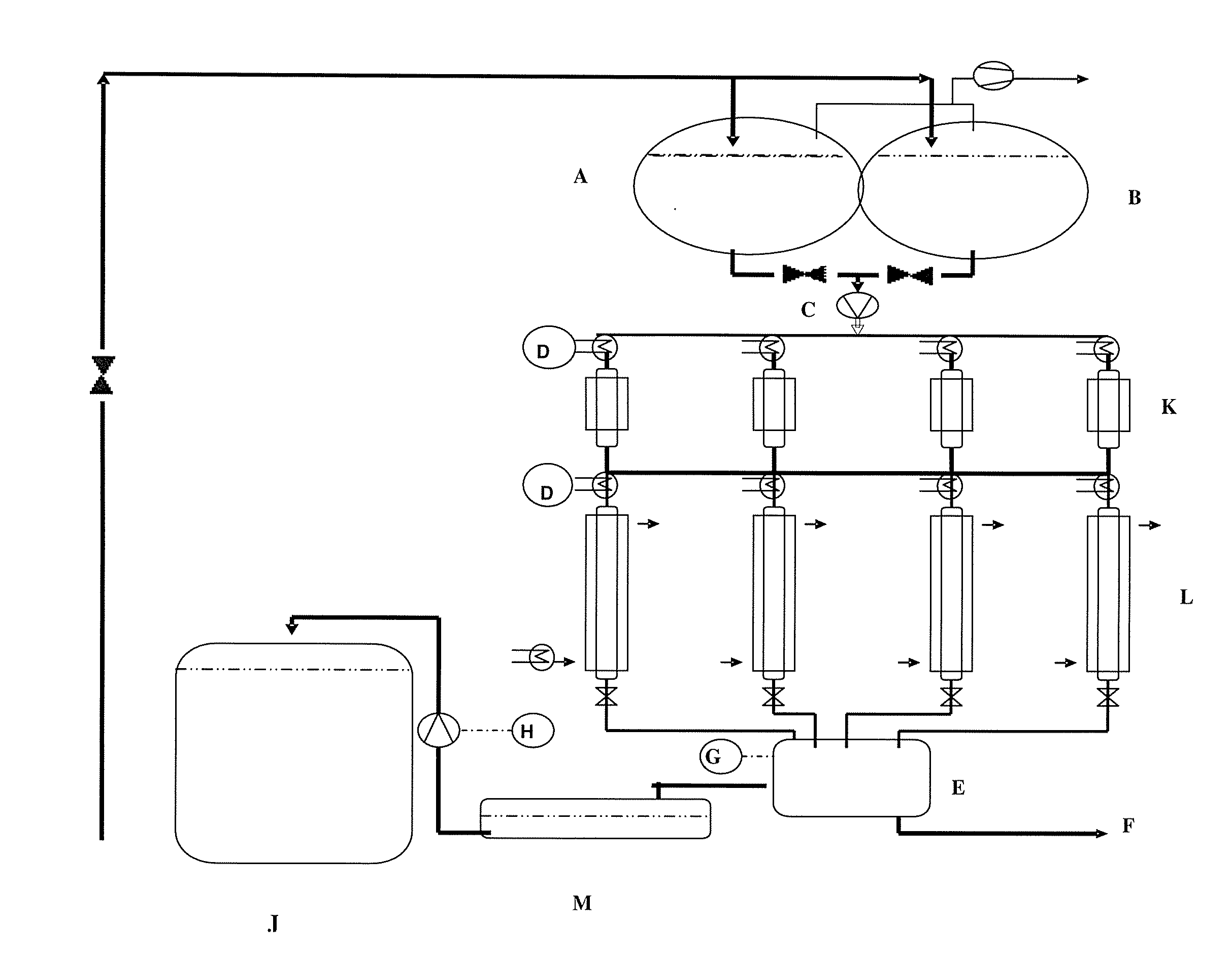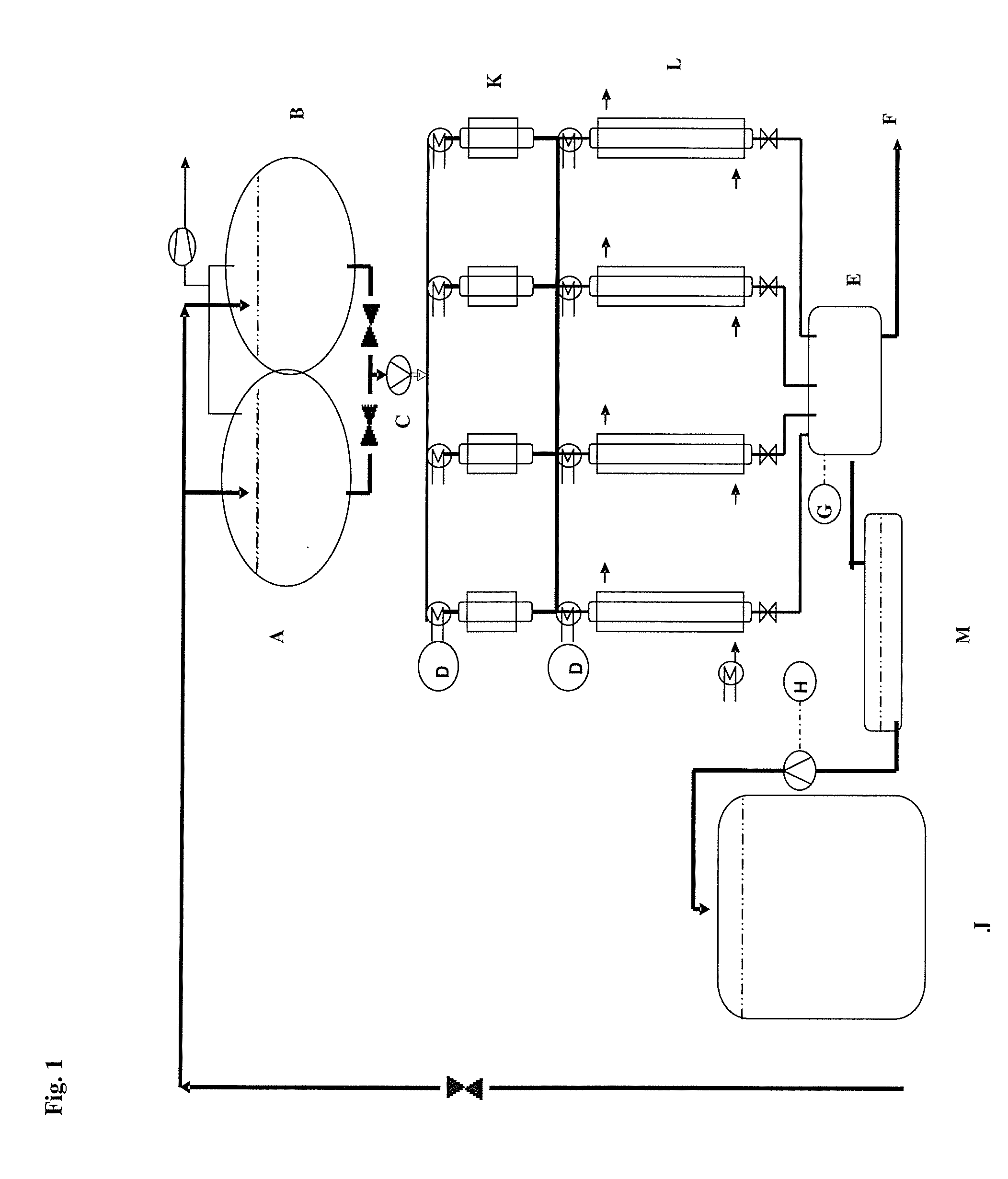Method for improved removal of cations by means of chelating resins
a technology of chelating resin and cation, which is applied in the direction of cation exchanger materials, separation processes, water/sewage treatment by ion exchange, etc., can solve the problems of increased specific energy consumption, decreased membrane performance, and high energy consumption, and achieves high total capacity
- Summary
- Abstract
- Description
- Claims
- Application Information
AI Technical Summary
Benefits of technology
Problems solved by technology
Method used
Image
Examples
example 1
[0160]1a) Production of the Monodisperse, Macroporous Polymer Beads Based on Styrene, Divinylbenzene and Ethylstyrene
[0161]In a 10 l glass reactor, 3000 g of demineralized water are charged and a solution of 10 g of gelatin, 16 g of disodium hydrogenphosphate dodecahydrate and 0.73 g of resorcinol in 320 g of demineralized water were added and mixed. The mixture was heated to and maintained at 25° C. With stirring, subsequently, a mixture of 3200 g of microencapsulated monomer droplets having a narrow particle size distribution of 3.6% by weight of divinylbenzene and 0.9% by weight of ethylstyrene (used as commercially available isomeric mixture of divinylbenzene and ethylstyrene containing 80% divinylbenzene), 0.5% by weight of dibenzoyl peroxide, 56.2% by weight of styrene and 38.8% by weight of isododecane (technical isomeric mixture having a high proportion of pentamethylheptane) was added, wherein the microcapsules consisted of a formaldehyde-cured complex coacervate of gelatin...
example 2
[0194]Calcium removal from a 30% strength sodium chloride solution using a chelating resin having aminomethylphosphonic acid groups (median bead diameter 0.41 mm±0.05 mm) in comparison with a chelating resin having aminomethylphosphonic acid groups as per EP 1 078 690 A2 (median bead diameter Ø0.65 mm±0.05 mm).
[0195]Experimental Description:
[0196]By means of a peristaltic pump, brine was continuously pumped over the ion exchangers of various grain sizes to be determined.
[0197]The subsequent experimental parameters were taken into account here:
Feed concentration 12 mg Ca / litreFeed pH 8.2Feed rate 20 BV / hColumn temperature 60° C.Breakthrough concentration 20 μg Ca / litreAmount of resin used100 mlResin formNa form
[0198]See FIG. 1 for experimental structure:
[0199]A=brine reservoir vessel 300 g of NaCl / litre; 400 litres capacity
[0200]B=brine reservoir vessel 300 g of NaCl / litre; 400 litres capacity
[0201]C=peristaltic pump
[0202]D=TIC (70° C.)
[0203]E=ADI (calcium titration)
[0204]F=waste wa...
example 3
[0226]Comparison of the characteristic data of the 2 chelating resins used in Example 2 having aminomethylphosphonic acid groups
TABLE 2Chelating resin Chelating resin accordinghaving ato the invention median bead having a diameter 650 μmedian beadaccording toCharacteristic datadiameter 413 μEP 1 078 690 A2Swelling factor ml of end11.159.2product per gramme of feedpolymer beadsMedian bead diameter in μ413650Amount of chelating 3.392.39groups (total capacity)in mol / lMedian pore diameter in nm7567Resin stability in the 2009998cycle swelling stability test in % whole beadsDynamic absorption 24.112.3capacity for calcium in grammes of calcium perlitre of chelating resinLoading duration of the96.753chelating resin until theamount of calcium in thefiltrate exceeds 20 ppb:in hours
[0227]The chelating resin having a median bead diameter of 413μ exhibits, compared with the chelating resin having a median bead diameter of 650μ, a very considerably higher absorption capacity for calcium in gramme...
PUM
| Property | Measurement | Unit |
|---|---|---|
| Temperature | aaaaa | aaaaa |
| Temperature | aaaaa | aaaaa |
| Time | aaaaa | aaaaa |
Abstract
Description
Claims
Application Information
 Login to View More
Login to View More - R&D
- Intellectual Property
- Life Sciences
- Materials
- Tech Scout
- Unparalleled Data Quality
- Higher Quality Content
- 60% Fewer Hallucinations
Browse by: Latest US Patents, China's latest patents, Technical Efficacy Thesaurus, Application Domain, Technology Topic, Popular Technical Reports.
© 2025 PatSnap. All rights reserved.Legal|Privacy policy|Modern Slavery Act Transparency Statement|Sitemap|About US| Contact US: help@patsnap.com



